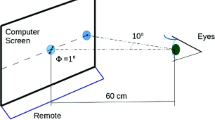Abstract
The present study was designed to evaluate whether fixation point offsets have the same effects on the average latencies of prosaccades (responses towards target) and antisaccades (responses away from target). Gap and overlap conditions were run with and without an acoustic warning signal. The ‘gap effect’ was taken to be the difference in mean reaction time between gap and overlap trials. This effect was dramatically reduced by the presentation of the warning signal. Without this signal, fixation offsets can serve as warning signals themselves, which artifactually inflates the magnitude of the gap effect. The warning effect of fixation offsets was equivalent for pro and antisaccades. A significant gap effect is still evident with the acoustic warning signal; however, in this case it is associated primarily with prosaccades. These results replicate and extend our previous work demonstrating that, if their warning effects are controlled, the facilitatory effects of fixation point offsets are response dependent, and suggesting the existence of a component process (fixation release) which is closely linked with the processing architecture underlying target-directed saccades.
Similar content being viewed by others
References
Fendrich R, Hughes HC, Reuter-Lorenz PA (1991) Fixation point offsets reduce the latency of saccades to acoustic targets. Percept Psychophys 50:383–387
Fischer B, Boch R (1983) Saccadic eye movements after extremely short reaction times in the monkey. Exp Brain Res 260:21–26
Fischer B, Breitmeyer B (1987) Mechanisms of visual attention revealed by saccadic eye movements. Neuropsychologia 25:73–83
Fischer B, Ramsperger E (1984) Human express saccades:extremely short reaction times of goal directed eye movements. Exp Brain Res 57:191–195
Fischer B, Ramsperger E (1986) Human express-saccades:effects of randomization and daily practice. Exp Brain Res 64:569–578
Fischer B, Weber H (1992) Characteristics of “anti” saccades in man. Exp Brain Res 89:415–424
Fischer B, Weber H (1993) Express saccades and visual attention. Behav Brain Sci 16:553–610
Fischer B, Weber H, Biscaldi M, Aiple F, Otto P, Stuhr V (1993) Separate population of visually guited saccades in humans: Reaction times and amplitudes. Exp Brain Res 92:528–541
Goldberg ME, Bushnell MC, Bruce CJ (1986) The effect of attentive fixation on eye movements evoked by electrical stimulation of the frontal eye fields. Exp Brain Res 61:579–584
Guitton D, Buchtel HA, Douglas RM (1985) Frontal lobe lesions in man cause difficulties in suppressing reflexive glances and in generating goal-directed saccades. Exp Brain Res 58:455–472
Hughes HC, Reuter-Lorenz PA, Fendrich R, Gazzaniga MS (1992) Bidirectional control of saccadic eye movements by the disconnected cerebral hemispheres. Exp Brain Res 91:335–339
Iwasaki S (1990) Facilitation of reaction times with GAP paradigm: comparison of manual and saccadic responses. Ergonomics 33:833–850
Kalesnykas R, Hallett PE (1987) The differentiation of visually guided and anticipatory saccades in gap and overlap paradigms. Exp Brain Res 68:115–121
Kingstone A, Fendrich R, Wessinger CM, Reuter-Lorenz PA (1995) Are microsaccades responsible for the gap effect? Percept Psychs
Kingstone A, Klein R (1990) Attention and express saccades. Bull Psychon Soc 28:512
Kingstone A, Klein RM (1993a) Visual offsets facilitate saccadic latency: does predisengagement of visuospatial attention mediate this gap effect? J Exp Psych: Human Percept Perf 19:1251–1265
Kingstone A, Klein RM (1993b) What are human express saccades? Percept Psychophys 54:260–273
Kirk RE (1968) Experimental design: procedures for the behavioral sciences. Wadsworth, Belmont, Calif
Klein RM, Kingstone AF (1993) Why do visual offsets reduce saccadic latencies? Behav Brain Sci 16:583–584
Munoz DP, Wurtz RH (1992) Role of the rostral superior colliculus in active visual fixation and execution of express saccades. J Neurophysiol 67:1000–1102
Nozawa G, Reuter-Lorenz PA, Hughes HC (1995) Parallel and serial processes in the human oculomotor system: bimodal integration and express saccades. Biol Cybern
Reuter-Lorenz PA, Hughes HC (1993) Warning signals, response specificity and the gap effect: implications for a non-attentional account. Behav Brain Sci 16:585–586
Reuter-Lorenz PA, Hughes HC, Fendrich R (1991) The reduction of saccadic latency by prior offset of the fixation point: an analysis of the “gap effect”. Percept Psychophys 49:167–175
Ross LE, Ross SM (1980) Saccade latency and warning signals: stimulus onset, offset and change as warning events. Percept Psychophys 27:251–257
Ross SM, Ross LE (1981) Saccade latency and warning signals: Effects of auditory and visual stimulus onset and offset. Percept Psychophys 29:429–437
Saslow MG (1967) Effects of components of displacement step stimuli upon latency for saccadic eye movements. J Opt Soc Am 57:1024–1029
Schiller PH, True SD, Conway JL (1980) Deficits in eye movements following frontal eye-field and superior colliculus ablations. J Neurophysiol 44:1175–1189
Schiller PH, Sandell JH, Maunsell JHR (1987) The effect of frontal eye field and superior colliculus lesions on saccadic latencies in the rhesus monkey. J Neurophysiol 57:1033–1049
Tam WJ, Ono H (1994) Fixation disengagement and eye-movement latency. Percept Psychophys 56:251–260
Tam WJ, Stelmach LB (1993) Viewing behavior: ocular and atentional disengagement. Percept Psychophys 56:251–260
Townsend JT, Ashby FG (1983) Stochastic modeling of elementary psychological processes. Cambridge University Press, Cambridge, UK
Wenban-Smith MG, Findlay JM (1991) Express saccades: is there a separate population in humans? Exp Brain Res 87:218–222
Author information
Authors and Affiliations
Rights and permissions
About this article
Cite this article
Reuter-Lorenz, P.A., Oonk, H.M., Barnes, L.L. et al. Effects of warning signals and fixation point offsets on the latencies of pro- versus antisaccades: implications for an interpretation of the gap effect. Exp Brain Res 103, 287–293 (1995). https://doi.org/10.1007/BF00231715
Received:
Accepted:
Issue Date:
DOI: https://doi.org/10.1007/BF00231715




